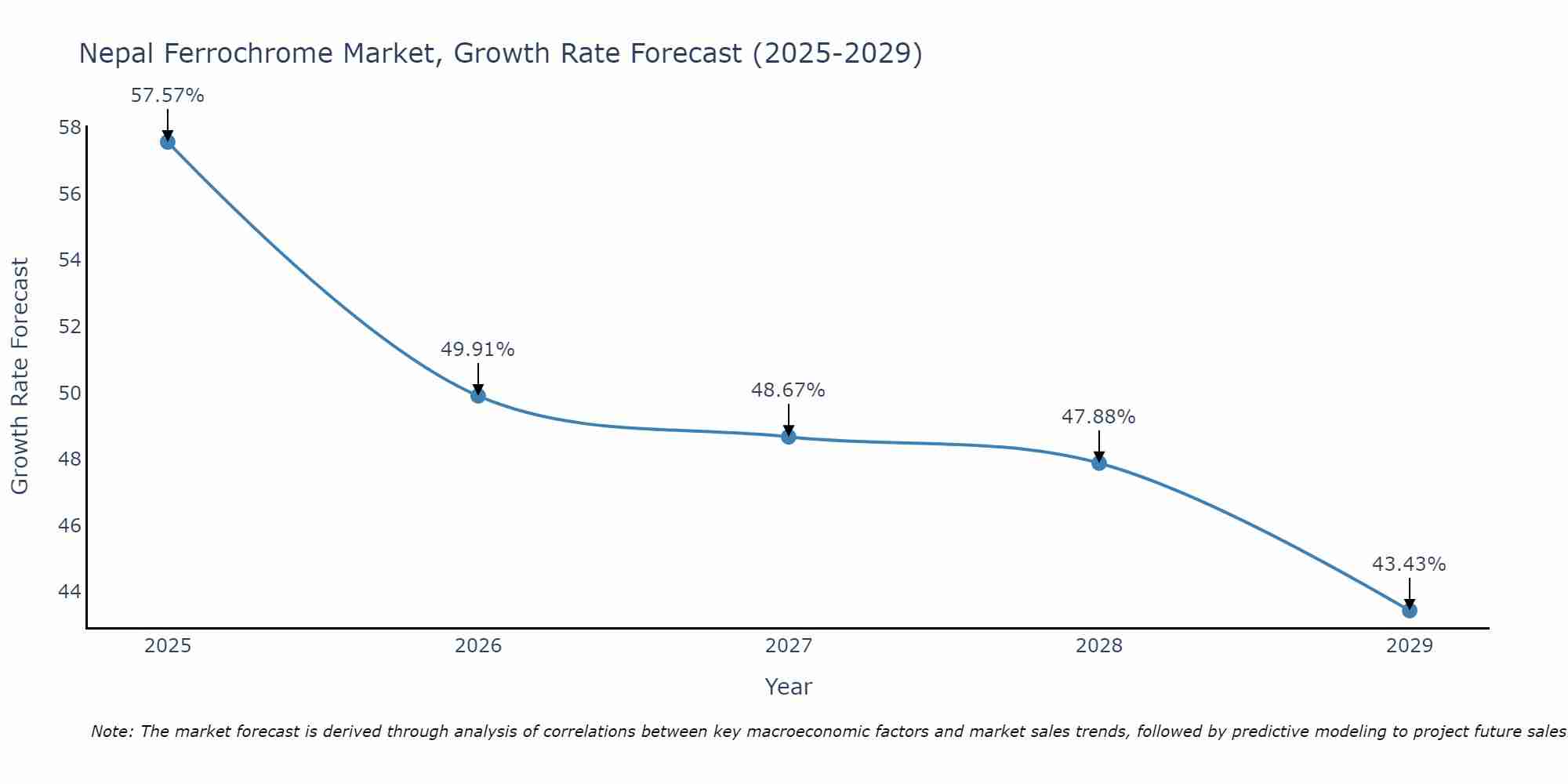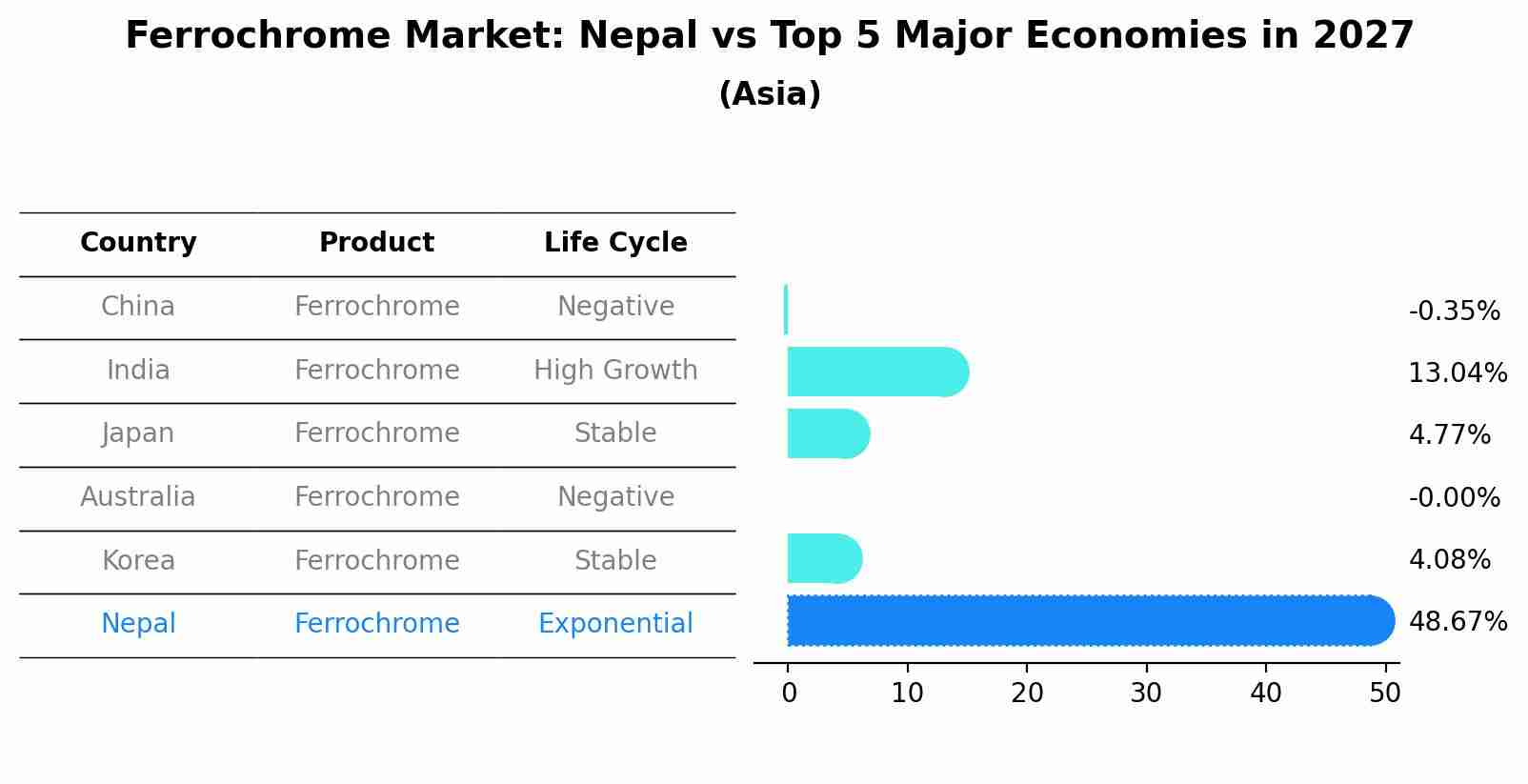Nepal Ferrochrome Market (2025-2031) Outlook | Value, Trends, Revenue, Share, Growth, Companies, Forecast, Industry, Analysis, Size
| Product Code: ETC092335 | Publication Date: Jun 2021 | Updated Date: Jun 2025 | Product Type: Report | |
| Publisher: 6Wresearch | Author: Dhaval Chaurasia | No. of Pages: 70 | No. of Figures: 35 | No. of Tables: 5 |
Nepal Ferrochrome Market Size Growth Rate
The Nepal Ferrochrome Market may undergo a gradual slowdown in growth rates between 2025 and 2029. Although the growth rate starts strong at 57.57% in 2025, it steadily loses momentum, ending at 43.43% by 2029.

Ferrochrome Market: Nepal vs Top 5 Major Economies in 2027 (Asia)
By 2027, Nepal's Ferrochrome market is forecasted to achieve a exponential growth rate of 48.67%, with China leading the Asia region, followed by India, Japan, Australia and South Korea.

Nepal Ferrochrome Market Overview
The Nepal Ferrochrome market is witnessing steady growth due to increasing demand from the stainless steel industry. Ferrochrome, an essential alloying element in stainless steel production, is crucial for enhancing resistance to corrosion and oxidation. The market is primarily driven by growth in infrastructure development, urbanization, and industrialization activities in Nepal. Additionally, the presence of abundant chromite reserves in the country further supports the local production of ferrochrome. Key players in the Nepal Ferrochrome market include both domestic producers and international companies operating in the region. With the stainless steel industry expected to continue expanding globally, the Nepal Ferrochrome market is poised for sustained growth in the coming years, presenting opportunities for market players to capitalize on the increasing demand for this vital alloy.
Nepal Ferrochrome Market Trends
The Nepal Ferrochrome market is experiencing growth due to the increasing demand from the stainless steel industry. The rise in infrastructure development projects and construction activities in the region has further boosted the demand for ferrochrome as a key component in stainless steel production. Additionally, the growing focus on renewable energy sources and electric vehicles has led to an increased demand for stainless steel, driving the market for ferrochrome in Nepal. Market players are also focusing on technological advancements and innovation to enhance production efficiency and meet the evolving needs of customers. However, challenges such as fluctuating raw material prices and environmental regulations are influencing market dynamics in the Nepal Ferrochrome industry.
Nepal Ferrochrome Market Challenges
In the Nepal Ferrochrome market, there are several challenges that industry players face. These include fluctuations in global market prices for ferrochrome, which can impact the profitability of local producers. Additionally, limited access to technology and equipment for efficient production processes hinders the industry`s competitiveness. Infrastructure constraints, such as unreliable power supply and transportation issues, also pose challenges to the smooth operation of ferrochrome plants in Nepal. Moreover, regulatory uncertainties and bureaucratic red tape can create obstacles for companies looking to invest or expand in the market. Overall, addressing these challenges will be crucial for the sustainable growth and development of the Nepal Ferrochrome market.
Nepal Ferrochrome Market Investment Opportunities
Investment opportunities in the Nepal Ferrochrome market are promising due to the country`s abundant reserves of chrome ore and the growing demand for ferrochrome in the global market. With Nepal`s proximity to key markets in India and Southeast Asia, there is significant potential for growth in the ferrochrome industry through exports. Investing in ferrochrome production facilities or mining operations in Nepal can provide attractive returns as the demand for stainless steel, which uses ferrochrome as a key ingredient, continues to rise. Additionally, advancements in technology and sustainable practices in the ferrochrome industry present opportunities for investors to capitalize on the growing trend towards environmentally friendly production methods. Overall, the Nepal Ferrochrome market offers a favorable investment landscape for those looking to tap into the country`s natural resources and strategic location.
Nepal Ferrochrome Market Government Policy
Government policies related to the Nepal Ferrochrome Market include regulations on mining activities, environmental protection measures, and export policies. The government has implemented licensing requirements and royalty fees for ferrochrome mining operations to ensure sustainable extraction practices. Environmental regulations are in place to mitigate the impact of mining activities on the ecosystem and local communities. Additionally, export policies dictate the quantity of ferrochrome that can be exported, aiming to balance domestic supply and demand while also promoting the growth of the local ferrochrome industry. Overall, these policies aim to regulate the ferrochrome market in Nepal, promote responsible mining practices, and support the growth of the domestic industry.
Nepal Ferrochrome Market Future Outlook
The Nepal Ferrochrome market is expected to show steady growth in the coming years due to increasing demand from the stainless steel industry. The market is likely to benefit from the country`s abundant chromite ore reserves and the government`s focus on promoting industrial development. However, challenges such as infrastructure constraints, regulatory hurdles, and competition from international players may hinder the market`s growth to some extent. Overall, with the right investment in infrastructure and technology, along with favorable government policies, the Nepal Ferrochrome market has the potential to expand and contribute significantly to the country`s economy in the future.
Key Highlights of the Report:
- Nepal Ferrochrome Market Outlook
- Market Size of Nepal Ferrochrome Market, 2021
- Forecast of Nepal Ferrochrome Market, 2031
- Historical Data and Forecast of Nepal Ferrochrome Revenues & Volume for the Period 2021 - 2031
- Nepal Ferrochrome Market Trend Evolution
- Nepal Ferrochrome Market Drivers and Challenges
- Nepal Ferrochrome Price Trends
- Nepal Ferrochrome Porter's Five Forces
- Nepal Ferrochrome Industry Life Cycle
- Historical Data and Forecast of Nepal Ferrochrome Market Revenues & Volume By Type for the Period 2021 - 2031
- Historical Data and Forecast of Nepal Ferrochrome Market Revenues & Volume By High carbon for the Period 2021 - 2031
- Historical Data and Forecast of Nepal Ferrochrome Market Revenues & Volume By Medium carbon for the Period 2021 - 2031
- Historical Data and Forecast of Nepal Ferrochrome Market Revenues & Volume By Low carbon for the Period 2021 - 2031
- Historical Data and Forecast of Nepal Ferrochrome Market Revenues & Volume By Applications for the Period 2021 - 2031
- Historical Data and Forecast of Nepal Ferrochrome Market Revenues & Volume By Stainless steel for the Period 2021 - 2031
- Historical Data and Forecast of Nepal Ferrochrome Market Revenues & Volume By Other steels for the Period 2021 - 2031
- Nepal Ferrochrome Import Export Trade Statistics
- Market Opportunity Assessment By Type
- Market Opportunity Assessment By Applications
- Nepal Ferrochrome Top Companies Market Share
- Nepal Ferrochrome Competitive Benchmarking By Technical and Operational Parameters
- Nepal Ferrochrome Company Profiles
- Nepal Ferrochrome Key Strategic Recommendations
Frequently Asked Questions About the Market Study (FAQs):
- Single User License$ 1,995
- Department License$ 2,400
- Site License$ 3,120
- Global License$ 3,795
Search
Related Reports
- Portugal Electronic Document Management Market (2025-2031) | Strategy, Consumer Insights, Analysis, Investment Trends, Opportunities, Growth, Size, Share, Industry, Revenue, Segments, Value, Segmentation, Supply, Forecast, Restraints, Outlook, Competition, Drivers, Trends, Demand, Pricing Analysis, Competitive, Strategic Insights, Companies, Challenges
- France Electronic Document Management Market (2025-2031) | Strategy, Consumer Insights, Analysis, Investment Trends, Opportunities, Growth, Size, Share, Industry, Revenue, Segments, Value, Segmentation, Supply, Forecast, Restraints, Outlook, Competition, Drivers, Trends, Demand, Pricing Analysis, Competitive, Strategic Insights, Companies, Challenges
- Portugal Occupational Health & Safety Services Market (2025-2031) | Strategy, Consumer Insights, Analysis, Investment Trends, Opportunities, Growth, Size, Share, Industry, Revenue, Segments, Value, Segmentation, Supply, Forecast, Restraints, Outlook, Competition, Drivers, Trends, Demand, Pricing Analysis, Competitive, Strategic Insights, Companies, Challenges
- Netherlands Occupational Health and Safety Services Market (2025-2031) | Strategy, Consumer Insights, Analysis, Investment Trends, Opportunities, Growth, Size, Share, Industry, Revenue, Segments, Value, Segmentation, Supply, Forecast, Restraints, Outlook, Competition, Drivers, Trends, Demand, Pricing Analysis, Competitive, Strategic Insights, Companies, Challenges
- Belgium and Luxembourg Facility Management Market (2025-2031) | Strategy, Consumer Insights, Analysis, Investment Trends, Opportunities, Growth, Size, Share, Industry, Revenue, Segments, Value, Segmentation, Supply, Forecast, Restraints, Outlook, Competition, Drivers, Trends, Demand, Pricing Analysis, Competitive, Strategic Insights, Companies, Challenges
- Russia Women Intimate Apparel Market (2025-2031) | Strategy, Consumer Insights, Analysis, Investment Trends, Opportunities, Growth, Size, Share, Industry, Revenue, Segments, Value, Segmentation, Supply, Forecast, Restraints, Outlook, Competition, Drivers, Trends, Demand, Pricing Analysis, Competitive, Strategic Insights, Companies, Challenges
- Africa Chocolate Market (2025-2031) | Size, Share, Trends, Growth, Revenue, Analysis, Forecast, industry & Outlook
- Global Hydroxychloroquine And Chloroquine Market (2025-2031) | Industry, Trends, Size, Outlook, Growth, Value, Companies, Revenue, Analysis, Share, Forecast
- Saudi Arabia Plant Maintenance Market (2025-2031) | Industry, Size, Growth, Revenue, Value, Companies, Forecast, Analysis, Share & Trends
- Taiwan Electric Truck Market (2025-2031) | Outlook, Industry, Revenue, Size, Forecast, Growth, Analysis, Share, Companies, Value & Trends
Industry Events and Analyst Meet
Our Clients
Whitepaper
- Middle East & Africa Commercial Security Market Click here to view more.
- Middle East & Africa Fire Safety Systems & Equipment Market Click here to view more.
- GCC Drone Market Click here to view more.
- Middle East Lighting Fixture Market Click here to view more.
- GCC Physical & Perimeter Security Market Click here to view more.
6WResearch In News
- Doha a strategic location for EV manufacturing hub: IPA Qatar
- Demand for luxury TVs surging in the GCC, says Samsung
- Empowering Growth: The Thriving Journey of Bangladesh’s Cable Industry
- Demand for luxury TVs surging in the GCC, says Samsung
- Video call with a traditional healer? Once unthinkable, it’s now common in South Africa
- Intelligent Buildings To Smooth GCC’s Path To Net Zero













